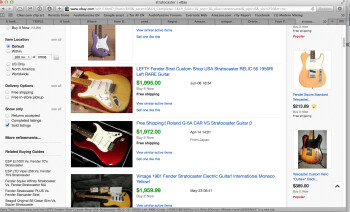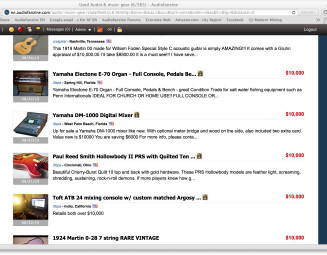If you’re a home recordist or a performing musician, chances are you have gear you want to sell. Perhaps you’re thinking of upgrading to something better, or you have extra hardware or instruments that you’re not using. Thanks to the Internet, your chances of finding a buyer are very good. The two most prominent sites for selling are eBay and Craigslist, although there are other options including Amazon.com.
Selling your gear is a lot easier now than in the pre- Internet days. Back then, your options were to take out a classified ad in your local newspaper, or maybe try to trade your gear to a music store, where you’d inevitably get less than if you sold it privately.
With eBay and Craigslist and other online gear-selling sites, things are a lot easier, but you’ll do much better if you know what you’re doing. In this multipart story we’ll offer advice to make your online sales smoother and more profitable.
Craigslist vs. eBay
These two online behemoths are conceptually very different. Craigslist is more of a local bulletin board in your own area or region, where you advertise your gear and prospective customers actually come to your house or apartment to look at the gear and hopefully buy it. Payments are generally made in cash.
On the other hand, eBay is a remote service, for the most part, where buyers purchase your gear based on photos and a description, and you have to ship it to them, unless you use eBay’s local pickup option.
Unlike Craigslist, eBay listings cost money (not a lot, typically) and you have to pay a commission (aka “Final Value Fee”) of 9% for a typical sale. On the back end of the deal, you get dinged close to 3% by PayPal, for handling the payment.
But eBay has one major advantage: reach. Your item listing will be seen by buyers all over the country (and even internationally — although international sales and shipping are somewhat problematic), so you have a much bigger pool of potential buyers. Of course, you also have more competition, which offsets the reach advantage to some degree. Because of its larger pool of buyers, you’re probably more likely to find someone interested in your item on eBay than on Craigslist, especially if it’s obscure.
Another advantage to eBay is its auction feature. If you have an item that’s desirable, it will frequently sell for well over asking, when buyers start bidding against each other. We’ll talk about pricing strategies in a subsequent installment of this story.
If you value privacy, eBay wins hands down, because you never come face to face with your potential customers. The closest you’ll come is through emails that you receive and send through the eBay website. If you’re selling on Craigslist, you have to let people come to your house or apartment (unless you can get then to meet you elsewhere) to checkout or test out the item to make sure its in working condition. There’s always somewhat of a risk when you’re letting strangers come into your home. Insist, in advance that customer pay you in cash. Definitely do not take a check, or you could get burned.
One of Craigslists’ biggest plusses is that you get to keep 100% of the proceeds of your sale. What’s more, it makes it possible to sell items that are too large to ship without incurring prohibitively high costs. Since Craigslist customers pick up the gear themselves, you can amps, drum kits, PA speakers, and other large items, which would be difficult and very expensive to ship for an eBay sale.
What’s more, you won’t have to worry about packing items up to ship, and you won’t need to buy bubble wrap, tape, and shipping boxes. Some gear, such as guitars or basses, requires special boxes that you’d probably have to order online.
Other options
You can also sell your musical instruments and recording gear on Amazon. Your reach will be good, because when somebody searches for a matching item on Amazon, the site will give them results that include both the price to buy new through Amazon and “More Buying Choices.” These are separated into “New” and “Used” categories, and if the latter is selected, your listing (and that of anyone else selling that item used) will show up. Amazon’s seller fees vary widely depending on the category. For musical instruments, they take a whopping 15% of the sale price, which is even more than eBay.
Dedicated music sites like Reverb are another option. Reverb charges only 3.5%, and only if your item sells. Otherwise there’s no charge. Like eBay and Amazon, it offers the buyers protection against fraud, which adds confidence and facilitates sales.
We now have a free classified section for selling gear right here at Audiofanzine. You can sell to other AF members directly, and get info on the gear through our database. We’re also hosting select listings from Craigslist, and soon from eBay. The Audiofanzine classifieds don’t provide an online payment mechanism, but you could use a site like PayPal, or arrange another private payment method between you and the buyer.
Sweetwater Trading Post, a service offered by mega music retailer Sweetwater, offers a no-fee classified section, as well. Additionally, you can find “For Sale” categories in other specialized gear-related forums online. The advantage to such sites is that you’re selling to a very targeted market. The disadvantage is that you probably won’t get as large an audience for your listing as with eBay or Craigslist.
In the next installment, we’ll offer specific tips for selling your gear and instruments on eBay.



